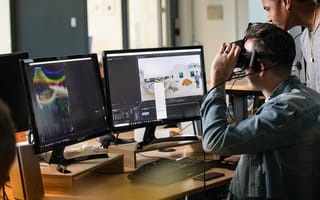“I missed you at mass today,” Beatriz’s daughter says, concerned. Beatriz never misses mass. What Beatriz hears, however, is, “I kissed you at mass today.” Beatriz suffers from Alzheimer’s disease, which can cause sounds to get distorted. She looks down at her lap and notices she’s still wearing pajamas. She missed mass because she forgot it’s Sunday.
Beatriz isn’t an actual person. She’s a simulation, as is her daughter, existing only in a virtual reality narrative Los Angeles-based startup Embodied Labs created to train healthcare providers and caregivers.
Embodied Labs’ trainees don an Oculus Rift or HTC Vive headset and step into the lives of patients with Parkinson’s disease, Lewy body dementia, Alzheimer’s, macular degeneration or high-frequency hearing loss. Sometimes, they see the world through the eyes of the patients themselves — a character with macular degeneration may see a fuzzy black dot in the middle of his field of vision, for example. Other times, trainees play the role of healthcare provider, delivering hard-to-hear updates to family members.
The goal of the training is to build empathy, the so-called soft skill that’s shot to prominence in healthcare, corporate and political spaces.
The word’s definition has evolved over time — and can be tough to pin down — but a common definition is the ability to understand another person’s perspective or see the world through their eyes. In its use of VR, Embodied Labs has become one of a handful of tech companies taking that definition more literally.
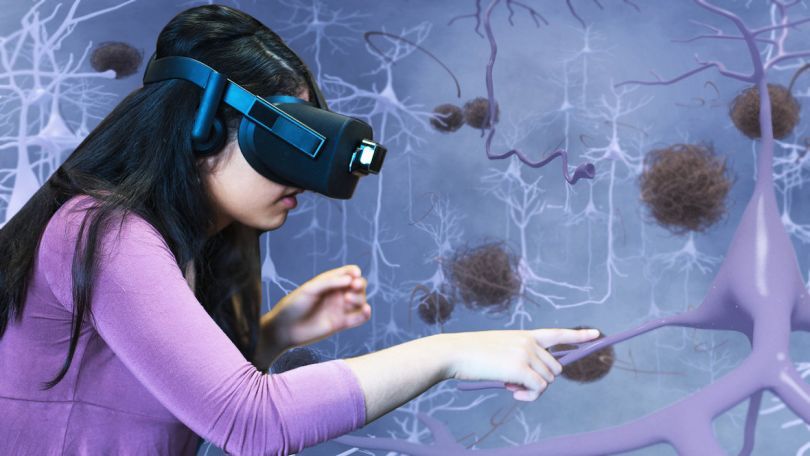
Empathy Is in Demand — & VR Is There to Help
Like any trendy concept, empathy has its supporters and detractors.
It’s been called “the most important leadership skill,” and the “mark of a compassionate and civilised society.” It’s also been called a “poor guide to moral decision-making,” “the official marketing buzzword of 2017” and — most pithily — “bullshit.”
Despite its vagaries, empathy seems to be gaining traction as a target for training. And organizations paying money for that training are looking for more than warm fuzzies.
“I do think it’s a buzzword,” said Erin Washington, co-founder and chief product officer at Embodied Labs. “VR gives people empathy in a way that we haven’t been able to experience before. But, for me, that doesn’t really matter unless it translates into action.”
What is empathy training?
For Washington, empathy isn’t an end in itself. And that argument actually works in VR’s favor: A virtual experience doesn’t just change a user’s perspective, she said. It changes a user’s brain.
Existing neurological research on VR backs her up. As a person works their way through a VR experience, they can see and hear the virtual environment, as well as interact with it physically by moving their body. This stimulates their sensory receptors, which creates new connections in their neural passageways. Ideally, those new connections affect their decision-making after the simulation ends.
“When you step into the world, it’s as if you learned all that, as if you really had that sensory experience,” said Michael Casale, chief science officer at Bay Area-based STRIVR. Casale, who earned a doctorate in cognitive neuroscience, helps STRIVR design custom VR-based training programs for companies.
The purpose of empathy training, Casale said, is not to create an emotion, but to harness an emotion to affect behavior. The trick is figuring out how to measure that behavioral change after the fact.
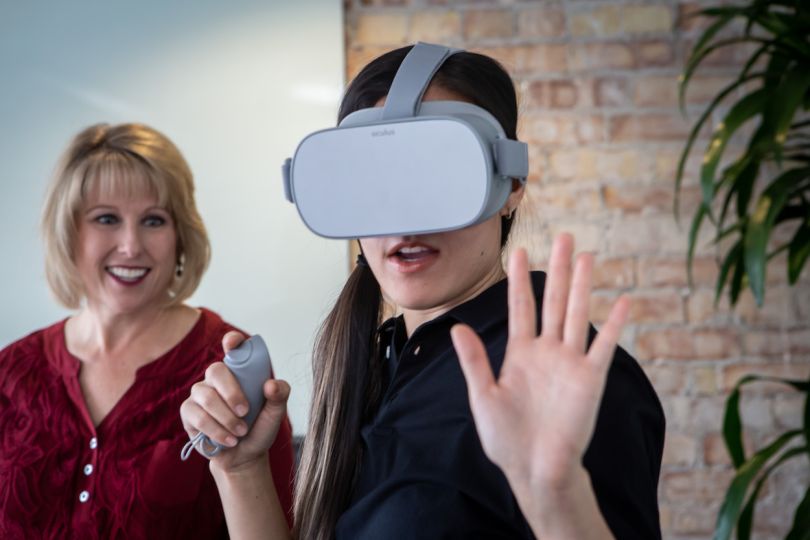
Empathy (Probably) Can’t Be Measured, But Its Effects Can
At STRIVR, what started as a way for athletes to practice repetitive moves in a low-stakes, virtual environment has evolved into customizable “immersive learning” programs for companies like Walmart, JetBlue and Verizon.
While STRIVR is still developing its soft skills training, it has already deployed what it calls customer de-escalation training to more than 1,000 employees at one of its client companies.
In the training, participants made their way through what felt like a normal day at work — completing tasks and chatting with customers. Some virtual customers were polite, while others became increasingly angry and impatient. Trainees had to make personal connections with the difficult customers to help them calm down.
The best VR training for soft skills, Casale said, incorporates both first-person practice and third-person perspective. In each interaction, he wanted the trainee to consider what the customer’s day might have been like and what the customer wanted from their interaction.
“Decisions get made based on what you think are the important factors. And suddenly you’re like, ‘Oh, here’s what’s important to a different person in this scenario,’” he said. “Everybody has a story, everybody’s going through some type of struggle, but it’s not enough just to say that.”
Measuring the efficacy of this type of training, Casale said, can also be a challenge. The client, whom Casale couldn’t name, wanted employees to remain calm and confident during stressful interactions, so STRIVR decided to use sentiment analysis to measure employees’ confidence before and after the training.
The STRIVR team, however, didn’t have a natural language processing tool that was up to the task. So they transcribed all the interactions by hand, hunting for keywords that showed trainees were using suggested strategies. They also analyzed recordings for the speed and fluency of each trainee’s speech.
“We have access to millions of people. That’s pretty wild from a data perspective.”
After two weeks of VR training, STRIVR found a marked increase in trainees’ verbal fluency when dealing with difficult customers, which indicated higher confidence, Casale said.
Eventually, teasing out measurable results should require a lot less labor. The key, Casale said, is data, and, as a training partner for huge, multinational companies, STRIVR will have a lot of it.
“We have access to millions of people,” he said. “That’s pretty wild from a data perspective.”
As STRIVR conducts more soft skills training, it will collect more data, which will improve its natural language processing tools. That will bring the company closer to an automated, high-confidence model for identifying key indicators and measuring behavioral changes — without tedious transcriptions or manual analysis.
More data and better natural language processing will also lead to more lifelike simulations. Virtual characters could become more dynamic, responding to what users say instead of performing a set sequence of reactions. That, in turn, will improve the quality of the data STRIVR gathers, which will make its VR even more realistic.
How long those advancements will take is tough to say, according to Casale, because it’s important not to overreach the model’s capabilities and destroy the illusion of reality — for example, if a virtual character responds in a way that doesn’t make sense.
“Ten years certainly seems realistic to have something good enough to where you don’t feel like you’re going to break the simulation,” he said. “But I’m speculating, and I think anyone else would be speculating at this point.”
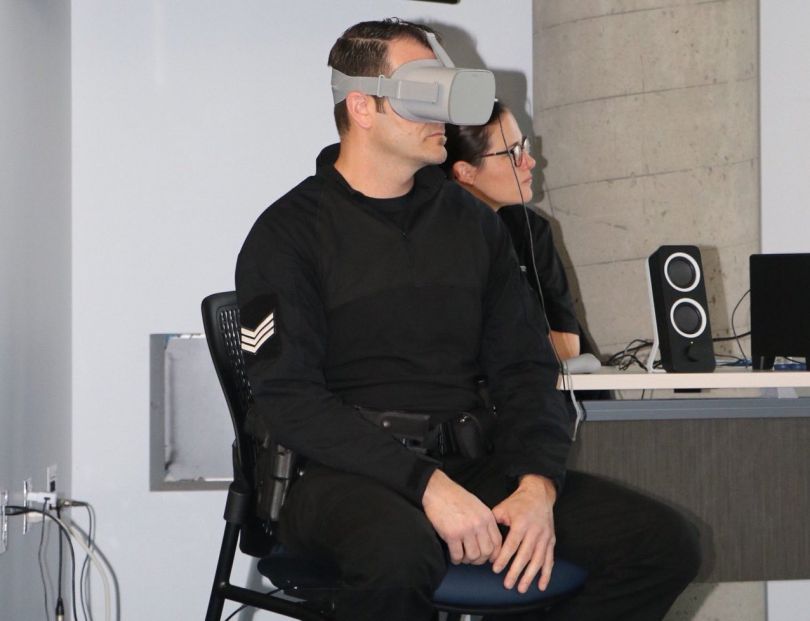
Measuring VR’s Efficacy While Protecting Participants’ Data
For some VR training companies, using participant data to measure results is more fraught.
Arizona-based Axon, best known as the company behind the Taser, has developed a VR empathy training program for law enforcement officers.
Axon, which also sells body cameras and software for law enforcement, runs an annual certification program for officers that use Tasers. In 2018, it added a standalone VR product for agencies wanting to train officers in crisis intervention.
The training focuses on the increasingly common scenario in which an officer responds to a call about an emotionally disturbed person. These calls, which often involve people with mental illnesses or neurological disorders, are especially challenging for officers without much knowledge of those disorders and their symptoms. Lacking context, it’s hard to know the most appropriate way to de-escalate the situation, since the reason behind a person’s emotional crisis likely will affect their reaction to an officer’s approach.
“We’re not asking anybody to do a full diagnostic or psychotherapy on site,” Brown said. “But we do want folks to have a general idea of whether someone is autistic or if they’re on drugs, for example.”
Axon built its crisis intervention training in the virtual realm for two reasons. The first is that it’s difficult to use role-play to accurately portray an emotionally disturbed person or a chaotic environment. The second is that VR seemed better suited to building empathy.
“Why we used VR for this is to help officers better understand what someone is experiencing when they’re in crisis.”
“Why we used VR for this is to help officers better understand what someone is experiencing when they’re in crisis,” Brown said. “The best way to understand why someone who is autistic is not verbally compliant is to understand what they’re going through during a meltdown: what they’re seeing, feeling, etc.”
Inside the simulations, officers practice responding to people in crisis, but they also experience what it’s like to be approached by a police officer while suffering from a frightening hallucination or sensory overload.
The ultimate goal is to reduce unnecessary use of force — in particular, use of Tasers on emotionally disturbed persons. But Brown is hesitant to collect data from the training to measure its efficacy. The link between an officer’s behavior in the simulation and their behavior in the field still isn’t clear, and Brown doesn’t want Axon’s data used in disciplinary proceedings if an officer makes a wrong choice.
“The VR we’re building right now is purely a learning exercise. It’s not a skills assessment. But if I were to tell you that an officer looked in this certain direction only and never looked left, or his heart rate increased when he saw a person in a certain condition, some folks would be led to make judgments of that officer,” she said.
Axon’s platform will someday collect performance data, Brown said, once the team better understands that data’s relationship to real-world policing. In the meantime, Axon’s in-the-works efficacy study will focus on measuring in-classroom skill transference, or a participant’s progress in terms of understanding symptoms and tactics for engaging with people who are schizophrenic, autistic or contemplating suicide.
Long term, Brown hopes to collaborate with agencies to measure skill transference into the field, which will require data on how often officers use force when dealing with emotionally disturbed persons.
“Unfortunately, we have a crisis in this country where the resources available to folks with mental illness are slim,” she said. “And we have police officers being the first responders to folks who are in mental-health crises.”
Eventually, Axon plans to expand the VR training to address cultural biases as well. As officers learn to see the nuances in particular interactions, Brown said, it changes the way they view people, even in situations they never trained for.
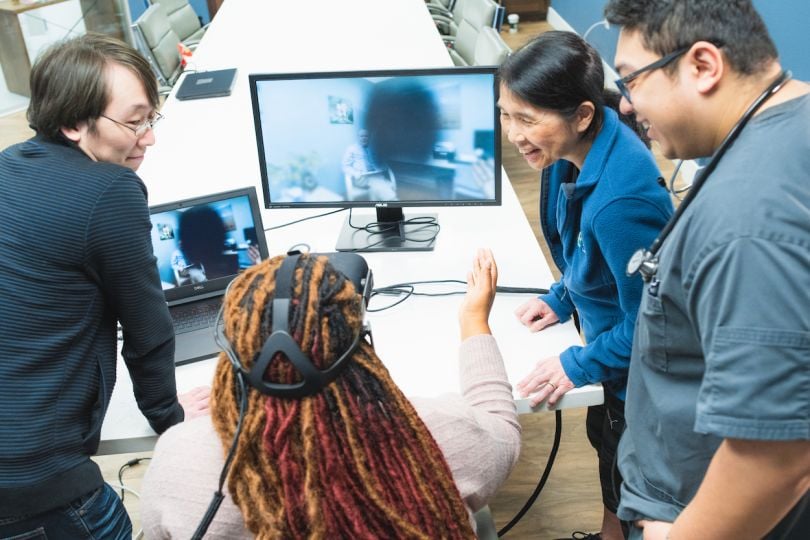
Defining Empathy’s Benefits Means Considering the Intangible
While Axon maintains a laser focus on decreasing unnecessary deployments of its Taser product, Embodied Labs has more wiggle room when it comes to measuring the efficacy of empathy training.
For healthcare providers, efficacy may mean more confidence having end-of-life conversations with grieving families. For family caregivers, an effective training may make them more receptive to assisted living options as they see the level of care their aging family member could require.
The company’s primary customers today are colleges and universities training medical and nursing students. In those labs, students answer questions before and after the simulation regarding their interest in — and perceptions of — geriatric care.
In a study described in an Embodied Labs white paper, second-year medical students at the University of Illinois–Chicago who completed one of the company’s labs were less likely than their peers to use stereotypical language — like “grandparent,” “frail” and “wise” — when describing older adults. They also reported higher confidence in their ability to understand the perspective of an aging patient.
“It could be your changed perspective allows you to sit in the living room with your mom who has Alzheimer’s disease, and instead of feeling fear and sadness, you’re able to experience joy.”
Most of Embodied Labs’ measurements are self-reported by users, which makes their implications tough to assess. As with STRIVR, the ability to autonomously analyze participants’ behavior within the simulation would be a huge stride toward more robust metrics.
“That’s something we are innovating and growing quite a bit more in 2020 as our company grows,” Washington said.
In the next few months, Washington said, the company plans to gather metrics showing what effects its training may have on professional caregiver retention and caregiver burnout, as well as key cultural and emotional competencies.
Embodied Labs also plans to work with institutional partners to access more longitudinal data about outcomes for its trainees and their patients or family members. While it hasn’t nailed down which indicators it will measure, Washington said via email, contenders include hospitalizations, engagements with emergency medical services and caregiver health problems. That will be one focus of its work with nonprofit mutual holding company GuideWell as part of the GuideWell Health Innovation Challenge, in which Embodied Labs was named a finalist.
In a world that’s — to borrow another buzzword — data-driven, demonstrating the value of a slippery concept like empathy training is essential for the businesses that offer it. But a change in perspective, Washington pointed out, is sometimes a gift in itself.
“‘Action’ doesn’t mean you have to go out and do something,” she said. “It could be your changed perspective allows you to sit in the living room with your mom who has Alzheimer’s disease, and instead of feeling fear and sadness, you’re able to experience joy and a sense of purpose and meaning.”

